| |
|
|
 |
|
|
WOW! This is a waaaaaay out of date referance. Please do not refer to this information for tank sizes, medication or tankmates. It is based on what we knew back in 2003 which was 7 years ago - we have learned a lot since then!!!
I will try to get the updated version live and correctly installed quickly. In the interrum, please refer to the linked PDF file. It is also a few years old, but offers better information, the current 'state of play' will be up shortly! PDF PRINTOUT
“Seahorses are strange,
beautiful, oddities of nature. But the very
things that make them so
fascinating to humans now threatens to lead
them to extinction.”
- ABC News
|
|
|
|
UPDATED: 26 December
2003
As many aquarium hobbyists
know, seahorses and related species have different
needs than other marine fish. This fact sheet
was created to assist anyone that is interested
in keeping these fascinating fish. The content
herein is meant to be a guideline for new seahorse
keepers based upon the experience of several
hundred seahorse hobbyists, Syngnathidae researchers,
and commercial breeders.
IMPORTANT NOTE: Although
we discuss wild caught (WC) as well as captive
bred (CB) seahorse strongly advise buying CB
seahorses. Captive breeding prevents decimation
of wild populations and supports responsible
and innovative breeding programs for those interested
in becoming seahorse breeders. In addition,
captive bred seahorses are much easier to keep,
having been trained to accept frozen food, pre-adapted
to aquarium conditions, and much less likely
to carry or spread disease. Their survivability
in captivity is significantly higher than that
of wild caught seahorses. In the end, it is
more cost effective and rewarding for the beginning
hobbyist to purchase CB seahorses.
WE RECOMMEND
THAT ALL BEGINNING KEEPERS PURCHASE ONLY CAPTIVE
BRED SEAHORSES.
|
|
|
|
PURCHASING HEALTHY SEAHORSES
|
|
|
|
|
|
|
|
|
|
|
|
|
|
|
|
|
|
|
|
|
|
|
|
|
|
|
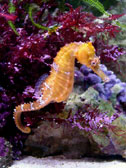 |
|
If you are buying from a local
fish store (LFS), observe the seahorses carefully
before you purchase. If you are buying from
an e-tailer, be sure they have a reputation
for supplying quality animals and a guarantee
of live arrival and survival for 5-7 days. Even
the smallest sign of disease or injury can result
in a mortality, as seahorses are extremely sensitive
and often succumb to pathogens not common to
other marine ornamental fish. To make matters
worse, treatments are quite different and have
fewer efficacies. The following are some questions
to ask of your local fish store or e-tailer,
particularly if you are purchasing WC animals.
If you are able to observe the seahorses onsite,
the following guidelines can help you with picking
out the best animals that are most likely to
survive. Even with a careful eye, WC seahorses
can look outwardly healthy, only to die within
a few days of purchase. Though there are no
guarantees when purchasing WC seahorses, this
may help to minimize mortalities:
|
|
|
Photographer:
Karen Barber
|
|
|
|
|
|
|
Is
the seahorse eating? What food is it eating and
how often is it being fed? Is the body well -
rounded with no signs of abdominal concavity? |
|
|
DO NOT BUY A SEAHORSE
THAT IS NOT EATING.
Even stressed, new arrivals should eat within
24 hours if it they are otherwise healthy and
kept in a clean, well-aerated tank. Often they
have only been offered brine shrimp, which is
not a normal food source in their native habitats.
Although this is not a healthy diet, if the
seahorse will take it readily, it is the first
sign of good overall health. However, if the
seahorses have been in the pet store for any
length of time, fed exclusively on un-enriched
brine shrimp, there is a good chance these specimens
will be malnourished. Seahorses only have a
rudimentary stomach and must continuously absorb
nutrients. Offering a non-nutritional diet for
more than several days will quickly deplete
the seahorse of necessary nutrients, making
it more susceptible to pathogens. Most malnourished
seahorses do not survive in the long term.
It is a better sign if the pet store is feeding
a more adequate diet. This could include enriched
brine shrimp, ghost shrimp (for larger seahorses),
Hawaiian red shrimp, or frozen mysis or similar
crustaceans . You are much more likely to succeed
with a seahorse that is trained to eat frozen
food, and it is cheaper and easier to obtain
and provide frozen food. Most CB seahorses have
been trained to eat frozen mysis or similar
appropriate food. Of the WC seahorses, H. erectus,
the lined seahorse from the North American Atlantic
seaboard, has the reputation of being easiest
to train to eat frozen foods. As part of a complete
diet, seahorses trained to eat frozen food should
regularly receive a variety of live foods as
well. Examples include ghost shrimp, enriched
brine shrimp, baby mollies, red shrimp, etc.
Some live food should be offered every week.
(Note: The dwarf seahorse, H. zosterae, is a
hardy species, but requires live food cultures
of brine shrimp nauplii (24+ hour post-hatched
vitamin/HUFA enriched baby brine shrimp), but
is very hardy if its nutritional needs are met.)
SIGNS TO OBSERVE FOR
POTENTIAL PROBLEMS
|
|
|
|
|
|
|
Are
there any signs of skin sloughing or discoloration,
inflammation, odd swimming behaviour, not using
a holdfast, lying on substrate or hitching upside
down, minimal eye movement, protruding eyes, blisters
anywhere on the body, inflamed gill slits, eroded
snout, any body or tail lesions, or continuous
heavy respiration? |
|
|
| This
is only a partial list of possible outward signs
of illness. It's also difficult to know what is
normal behaviour (e.g., normal eye movement, respiration)
without an experienced eye for seahorse observation.
If any of the above descriptions are present,
play it safe and pass on the purchase. Resist
buying an apparently healthy animal if its tank
mates show signs of disease, as it is likely to
be infected as well. To "rescue" an
obviously malnourished or sick seahorse is tempting.
Try to resist the temptation; most sick seahorses
will die, and you risk introducing disease pathogens
into your |
|
|
|
aquariums. In addition, you
will be rewarding an aquarium shop for poor
husbandry practices and for selling unhealthy
WC seahorses. Instead, urge the store to maintain
and feed seahorses properly and to stock CB
animals.
CB seahorses, maintained in
a mature tank with good water quality (ammonia
and nitrite, zero; nitrate <20 ppm) and fed
an appropriate diet may be expected to live
for several years without serious health problems.
WC seahorses, on the other hand, often show
signs of
|
|
|
|
|
|
|
|
|
|
|
|
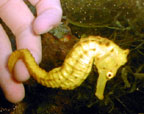 |
|
|
|
|
|
Photographer:
Tamara Weiss
|
|
| disease,
particularly as they are being newly established
in the home aquarium. For either WC or CB, it
is imperative to have medications on hand, so
that you can be prepared to treat a disease outbreak
before it overtakes one or all of your animals.
The following medications have been recommended
by the author and members of Seahorse.org to keep
on hand in case of illness. Before treating, be
sure to diagnose the disease and determine the
best course of treatment. The "Articles"
section in the Seahorse.org library includes information
on diseases and treatments, and the discussion
board has an Emergency forum staffed by experienced
keepers and breeders to help with your questions. |
|
|
|
RECOMMENDATIONS FOR THE MEDICINE
CABINET
|
|
|
|
|
|
|
|
|
|
|
|
|
|
|
|
|
|
|
|
|
|
|
|
|
|
|
| You
should have these medications on hand when you
purchase your seahorse. As you become more knowledgeable
about them, you may find that you prefer other
medications; this is just a guideline. Most of
these medications can be found at a well-stocked
LFS. |
|
|
Be
sure to have on hand:
Formalin 3 and Neosporin (triple antibiotic ointment)
as a topical solution.
(Betadine will do in a pinch.)
Kanacyn
Methylene blue
Furan-2 or Triple Sulfa
Tetracycline
Erythromycin
Metronidazole
Neomycin
Nitrofurazone
Optional:
Maracyn II
Furanase
Paragon II
Melafix
Malachite Green
Important meds that may be obtained through your
veterinarian or MD:
Acetazolamide (Diamox)
Ceftazime (Fortran)
Praziquantel (Droncit)
Essential tools to have
on hand:
Fine gauge IV catheter flexible tubing (without
needle)
Tuberculin syringe with needle removed
Loose hairpin with soft plastic tip
|
|
|
|
|
|
|
|
|
|
|
|
|
|
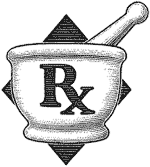 |
|
|
|
|
| NOTE:
Seahorse.org is attempting to make the essential
medications and tools available through the website. |
|
|
|
ACCLIMATION AND QUARANTINE
|
|
|
|
|
|
|
|
|
|
|
|
|
|
|
|
|
|
|
|
|
|
|
|
|
|
|
|
Acclimation procedures do not
differ from other fish except for the use of
nets, as netting often damages the bony plates
and the delicate dermal layer of the seahorse.
Preferable methods include gently coaxing them
into a plastic container for transfer or hand
transfer. If the latter method is used, it is
advisable to make the transfer quickly to avoid
undue stress.
All WC purchases should be
given a freshwater dip or formalin bath and
ideally be kept in a separate display or quarantine
tank for 2-4 weeks before introducing them to
a tank with other seahorses. Seahorses are more
sensitive than most fish to the FW dip, thus
if they show signs of distress (e.g. thrashing,
lying on bottom) lasting more than around 15
seconds, remove them immediately, regardless
of the maximum 3 -5 minutes required to remove
or kill external parasites. We do not advocate
mixing CB and WC seahorses in a tank, as even
apparently healthy WC seahorses may be asymptomatic
carriers of disease that could decimate CB seahorses
that may not have resistance to the disease.
Observe all new purchases carefully for any
odd behaviour or external lesions, spots or other
anomalies. Usually the first sign of illness
is cessation of appetite, but this is not a
hard and fast rule. If any signs of illness
are suspected, there is a comprehensive disease
guide at www.seahorse.org.
Alternately, you can post the
problem on the discussion board under Emergency
if anything seems amiss. There are several expert
keepers who will be around to help you with
the problem and answer your questions. Please
do not treat a seahorse without knowing what
pathogen is affecting it. Additionally, never
use copper-based solutions on seahorses or pipefish.
Their internal organs are too delicate to withstand
copper treatments.
|
|
|
|
THE SEAHORSE TANK
|
|
|
|
|
|
|
|
|
|
|
|
|
|
|
|
|
|
|
|
|
|
|
|
|
|
|
|
Seahorses should be introduced
into a mature, cycled aquarium. Numerous filtration
methods and tank set-ups can result in a healthy,
stable seahorse aquarium. A seahorse tank must
have gentle to moderate currents. Be sure there
is adequate biological filtration and do regular,
partial water changes of 5-20 percent per week
as you would with any fish-only aquarium, to
keep water parameters as listed below. Water
parameters should be stable before animals are
added:
pH - 8.0 to 8.3
Specific gravity - 1.021 to 1.024
Ammonia - 0
Nitrite - 0
Nitrate - <20 ppm
Optimum temperature is dependent on whether
the seahorse species being kept are tropical,
subtropical or temperate. Generally, most beginners
should start with tropical species unless the
tank is equipped with a chiller unit. Heating
tanks is much less expensive than cooling them.
Use a high quality submersible heater. Many
Seahorse.org members use Ebo Jaeger heaters
as they have more reliable than average performance
and do not feel hot to the touch, minimizing
the chance of burning a seahorse that hitches
to the heater. Allow about 4-watts per gallon
when selecting an aquarium heater.
This is not a hard and fast
rule, but most seahorse aquarists use taller
tanks. Seahorses need height (2.5 to 3 times
the UNCURLED length of the animals) in their
tanks to court and mate. At a minimum, the depth
of the tank, excluding the substrate, should
be at least 2x the uncurled length of the animal.
Further, leave a path along the substrate as
some seahorses courting rituals require them
to scoot along the bottom of the tank in tandem.
Several pairs of pygmy seahorses can be maintained
in a 5-10 gallon tank (a 10G is recommended
because of the difficulties of keeping water
parameters stable in a small capacity aquarium.
Two to three pairs of medium sized seahorses
can be maintained in a 24-gallon tank although
a larger tank is preferable to keep water parameters
more stable.
|
|
|
|
|
|
|
|
|
|
|
|
|
|
Temperature Requirements
and Stocking Density of Commonly Available Seahorse
Species
Note: This is to be used as a guideline. Keeping
temperature constant is extremely important
and although it is typically better to keep
them at the lower ranges below, stability is
key. One degree more or less is not a problem
as long as temperature swings do not exceed
2 degrees maximum in a 24-hour range. Surface
turbulence using power heads (water pumps),
air pumps, and fans can help to lower and stabilize
temperatures if necessary.
|
|
|
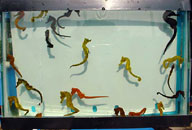 |
|
|
|
|
Photographer:
Eliezer Zuñiga Villarreal
|
|
|
|
|
Here is a list of commonly
avaliable seahorse species grouped by their
temperature range. You can not mix species from
differing temperature ranges. Also listed is the
recommended minimum tank size for two pairs of
adult seahorses of each species, as well as the
'additional' space required by each additional
pair. These are guidelines. Several people keep
seahorses successfully in much smaller tanks,
but we do not recommend this.
1) Tropical species - kept at 74-78 degrees F (24-26 degrees C)
zosterae, 1 pair/1.5 gallons (6 liters) -
recommended 5 gallons (20 liters)
kuda, 1 pair/8 gallons (30 liters)- minimum
size 15 gallons (60 liters)
barbouri, 1 pair/8 gallons (30 liters)-
minimum size 15 gallons (60 liters)
erectus, 1 pair/8 gallons (30 liters)- minimum
size 15 gallons (60 liters)
reidi 1 pair/8 gallons (30 liters)- minimum
size 15 gallons (60 liters)
fuscus 1 pair per 5 gallons (20 liters)-
minimum size 10 gallons (40 liters)
comes 1 pair/8 gallons (30 liters)- minimum
size 15 gallons (60 liters)
procerus 1 pair/8 gallons (30 liters) -
minimum size 15 gallons (60 liters)
2) Subtropical species - kept at 70-74 degrees F (22-25 degrees C)
whitei, 1 pair/8 gallons (30 liters)- minimum
size 15 gallons (60 liters)
ingens1 pair/13 gallons (50 liters)- minimum
size 45 gallons (180 liters)
tuberculatus, 1 pair/5 gallons (20 liters)-
minimum size 15 gallons (60 liters)
3) Temperate species - kept at 66-72
degrees F (19-22 degrees C)
abdominalis, 1pair/13 gallons (50 liters)-
minimum size 60 gallons (240 liters)
capensis 1 pair/5 gallons (20 liters)- minimum
size 10 gallons (40 liters)
breviceps, 1 pair/5 gallons (20 liters)-
minimum size 10 gallons (40 liters)
|
|
|
|
CHOOSING SAFE TANK MATES
|
|
|
|
|
|
|
|
|
|
|
|
|
|
|
|
|
|
|
|
|
|
|
|
|
|
|
| The
following hardy invertebrates are generally regarded
as safe tank mates for medium to large seahorses
and do not require special lighting, as do corals.
Use caution when adding animals to the tank; seahorses
are not strong swimmers, are not competitive feeders,
and have very few defenses against aggression.
With the exception of these clean-up crew animals
it is generally advisable to |
|
|
| establish
seahorses first, then add other animals. Remove
a tank mate at the first sign of aggression. Many
potential tank mates can help control algae and/or
clean up uneaten food. Other animals such as certain
non-aggressive fish and corals may be housed with
seahorses; this is just a partial list of compatible
"clean up crew" animals considered most
likely to be safe with small to large seahorses.
Not all of these animals should be considered
safe with seahorse fry. See the tank mates section
of Seahorse.org for a more comprehensive list. |
|
|
|
|
|
|
|
|
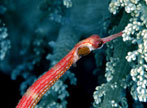 |
|
|
|
Photographer:
Robert Sozzani
|
|
NOTE:
Be sure you research the requirements of any
compatible animals you wish to add to the seahorse
tank before purchasing. For example, many corals,
sponges, and gorgonians require special reef
lighting or high water flow to thrive.
Fan worms including Feather
Dusters (Phylum Annelida)
Astrea Snail (Lithopoma [Astraea] spp.)
Turbo Snail (Turbo spp.)
Nassarius Snail (Nassarius vibex)
Trochus Snail (Trochus niloticus)
Cerith Snail (Family Cerithiidae)
Nerite Snail (Nerita spp.)
Fighting Conch (Strombus alatus)
Blue-legged Hermit Crab (Clibanarius tricolor)
Skunk Cleaner Shrimp (Lysmata amboinensis)
Peppermint Shrimp (Lysmata wurdemanni)
Scarlet/Blood Shrimp (Lysmata debelius)
Rockpool Shrimp (Palaemon elegans)
Grass Shrimp (Palaemonetes vulgaris)
(Shrimp are not considered safe around seahorse
fry or H.zosterae (dwarf seahorse).
Notable groups that should
be avoided:
Tangs, Triggerfish, Groupers, , Eels, Nudibranchs,
Filter-feeding Sea Cucumbers, Sea Urchins with
sharp spines, Fireworms, Spanish Dancer Flatworms,
Fire Corals, Lace Corals, Anemones, Tube Anemones,
all Cephalopods (Squids, Octopuses, Cuttlefish,
and Nautilus-), Mantis Shrimp, Lobsters, Heliofungia
spp. Corals, Cataphyllia spp. Corals, Euphyllia
spp. Corals, Goniopora/Alveopora spp. Corals,
Galaxea spp. Corals, and Hydnophora spp. Corals.
|
|
|
|
NUTRITION
|
|
|
|
|
|
|
|
|
|
|
|
|
|
|
|
|
|
|
|
|
|
|
|
|
|
|
|
With a little patience, WC
seahorses can be trained to eat dead/frozen
foods. There are numerous ways to coax them
into taking it. (You can find a "how-to"
at www.seahorse.org under "Articles"
which explains the procedure.) This not only
makes the job of feeding them a great deal easier
and less expensive, it increases their chances
of long-term survival, particularly with less
experienced seahorse keepers. If you are having
a lot of trouble getting your new seahorses
to take frozen food, a short-term solution is
to feed enriched artemia, (brine shrimp), ghost
shrimp for larger species; and Hawaiian red
shrimp. (See Seahorse.org for enrichment procedures.)
The need to start with live food is usually
necessary when purchasing WC seahorses unless
the staff at your LFS has already trained them.
It is good husbandry to continue to regularly
offer live foods to seahorses that primarily
subsist on frozen foods. Try to offer live foods
at least once or twice a week.
The enriched artemia should
always be rinsed in freshwater prior to feedings
to kill or remove any harmful bacteria, and
offered two to three times per day at three
to six hour intervals. Some larger seahorse
species may not readily take the brine shrimp,
and will require live ghost/glass shrimp. These
are a much more nutritional food source (or
supplement) than the artemia-only diet. Finally, if you don't
want to go to all this trouble maintaining the
WC seahorses, your other option is to purchase
only CB (captive bred) species that have already
been trained to eat frozen foods, such as mysis
(Mysis relicta), or mysids making feeding a
much more simple task. Offer the frozen food,
pre-thawed and rinsed, once or twice daily.
Initially watch the seahorses carefully to see
that all are getting their fill, and then adjust
the amount of food offered accordingly. Again,
remember to supplement a diet of frozen food
with live foods offered at least once per week.
|
|
|
|
KNOW YOUR SPECIES
|
|
|
|
|
|
|
|
|
|
|
|
|
|
|
|
|
|
|
|
|
|
|
|
|
|
|
|
Often, temperate species are
available for the home aquaria. One of the most
popular species currently being sold is the
pot-bellied seahorse, H.abdominalis or H.bleekeri.
This is a wonderfully active, curious seahorse
that has captured the heart of many hobbyists.
If you choose to carry them, it is critical
to hold them at optimum temp ranges (66-70F/19-21C).
You will need to purchase a chiller to maintain
optimum temperatures. Be forewarned that chillers
are very expensive pieces of equipment.
NOTE: Any fact sheets
purporting that these species can be kept at
tropical temperature ranges is false and will,
without exception, cause the demise of a subtropical
and temperate species within a few days. It
is in your own best interest not to purchase
from breeding facilities that claim otherwise,
nor to disseminate this misinformation.
|
|
|
| Most
of the WC seahorses supplied to pet stores are
collected from the tropical Indo-Pacific or Caribbean
regions. These species are most comfortably kept
at temperature ranges between 74-78F/24.5-26C.
There are several species regularly offered, but
again, many of these same species are also being
domestically bred. You can find excellent photos
and descriptions, and other specifics on each
species at www.seahorse.org. Many new seahorse
hobbyists purchase seahorses from their local
aquarium dealer without being aware of which species
they own. We frequently get questions on species
ID and care at Seahorse.org. If your dealer is
not certain of the scientific name of the species
of seahorse he/she |
|
|
|
|
|
|
|
|
|
|
|
|
|
|
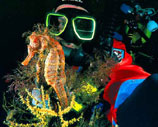 |
|
|
|
|
Photographer:
Barry Lipman
|
|
| carries,
you can ID your species at Photo Gallery at Seahorse.org
. If still unsure, a digital photo may be uploaded
and linked to on the Seahorse.org site. One clear
photo showing the dorsal spines and head/snout
should be sufficient for ID purposes. Common names
can be misleading. Find their scientific equivalent
and make sure you find out about any specific
needs particular to the species purchased. |
|
|
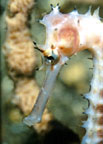 |
|
|
|
|
|
|
|
|
|
|
|
|
|
|
|
|
|
|
|
|
|
BEFORE YOU BUY,
be sure you understand the basic principles
of how to keep seahorses in the home aquarium.
Again, the best overall source for this is at
Seahorse.org. Keeping marine fish of any type
requires a solid knowledge of basic marine chemistry.
There are many books available and sources on
the internet on this topic. If you prepare adequately
and take the time to set up an appropriate sized,
fully cycled, and stable tank environment for
your seahorses, you will greatly improve your
chances of success.
NOTE:
Although temperature ranges may be similar,
it is not wise to keep tropical seahorses in
a captive reef environment. They cannot compete
for
|
|
|
|
|
Photographer:
John Randall
|
|
|
|
|
|
food and may be stressed by pelagic fishes, such
as tangs and wrasses. The water circulation in
a standard reef tank is much higher than the low
to moderate water turnover for seahorses. In an
attempt to find a holdfast, they may grasp onto
corals and anemones, consequently receiving a
potentially deadly sting. Seahorses are best kept
in a species tank; that is, a tank specifically
set up for keeping primarily one species. |
|
|
| Check
with your LFS or at Seahorse.org for information
on how to best obtain a particular species. |
|
|
|
 |
|
|
|
|
|
|
|
|
|
|
|
|
|
|
|
|
|
|
|
|
|
|
|
|
No matter where you live, it
is not usually difficult to have CB seahorses
ordered for you from your LFS. |
|
| This
fact sheet was created for the new seahorse hobbyists
by Seahorse.org (www.seahorse.org), a nonprofit
organization committed to the education and ethical
treatment of seahorses in captivity. Please distribute
this document freely to all parties interested
in keeping seahorses. |
|
|
|
|
|
|
|
Copyright
2003, Seahorse.org
|
|
|
 |
 |
 |
 |
 |
 |
 |
 |
 |
 |
 |
 |
 |
 |
 |
 |
 |
 |
 |
 |
 |
 |
 |
 |
|
|

